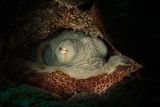Research into the sleep patterns of octopuses has led to intriguing discoveries about the possibility of these creatures experiencing dreams. A study published in the journal Nature indicates that octopuses, specifically the species Octopus laqueus, enter phases of sleep that are marked by vivid color changes and rapid arm movements, suggesting a dream-like state similar to what humans experience.
To better understand these phenomena, researchers from the University of Washington conducted experiments to confirm that octopuses were genuinely asleep. By gently prodding the animals during different sleep phases, they observed a notable difference in responsiveness. The octopuses reacted less to stimuli during sleep than when awake, confirming their state of rest. During the calm phase, the octopuses appeared white and motionless, while active sleep was characterized by bursts of movement and neural activity.
Investigating Sleep Patterns and Brain Activity
The research team utilized advanced techniques to monitor the octopuses’ brain activity while they were awake and asleep. During periods of quiet sleep, they detected neural patterns resembling mammalian sleep spindles, a type of brainwave associated with memory consolidation in humans. These spindle-like waves were found in brain areas connected to learning and memory, indicating a complex cognitive process.
Approximately once every hour, the octopuses entered a short phase of activity lasting about one minute, during which their brain patterns resembled those of awake states. This observation aligns with characteristics of human REM sleep, where dreaming occurs. Leenoy Meshulam, a statistical physicist involved in the study, noted, “The fact that two-stage sleep has independently evolved in distantly related creatures, like octopuses, suggests that possessing an active, wake-like stage may be a general feature of complex cognition.”
Colorful Displays and the Nature of Dreams
One of the most remarkable aspects of octopuses is their ability to change skin color and patterns using specialized cells. To analyze this behavior during sleep, the team filmed the octopuses in ultra-high 8k resolution. This allowed them to observe how individual pigmented cells behave, revealing that the skin patterns during active sleep mirrored those seen when the animals were awake.
The findings led researchers to consider the implications of these skin changes. The alternating patterns might indicate that octopuses are processing memories or rehearsing camouflage techniques while asleep. Senior author Sam Reiter explained, “In this sense, while humans can verbally report what kind of dreams they had only once they wake, the octopuses’ skin pattern acts as a visual readout of their brain activity during sleep.”
These discoveries suggest that the capacity for complex sleep, including a REM-like phase, may not be limited to mammals. Instead, it appears that various species, including octopuses, have evolved unique methods of experiencing and processing their dreams.
The research opens new avenues for understanding cognition in non-mammalian species and challenges existing perceptions of how different animals experience sleep and dreaming. The findings underline the intricate relationships between sleep patterns and cognitive functions across species, indicating a broader evolutionary significance that warrants further exploration.
